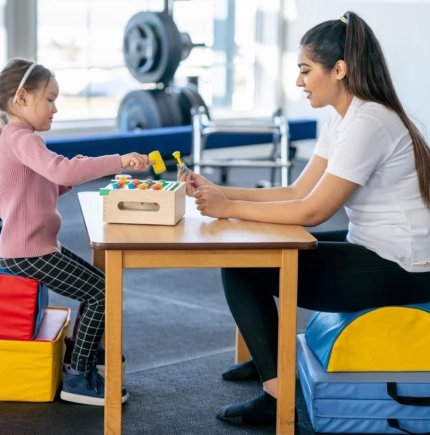Occupational therapy is a crucial component of effective recovery. After a serious injury or illness, individuals often experience a loss of fine motor skills and mobility.
Everyday tasks, such as making the bed or putting on clothes, are activities we often take for granted when we are healthy. However, for those recovering from conditions like stroke or other serious illnesses, re-learning these fundamental abilities is essential for returning to a normal life.
This comprehensive guide on occupational therapy will outline what patients can expect during their recovery journey and how occupational therapy can aid in regaining independence.


At the Cambridge Medical & Rehabilitation Center (CMRC), we specialize in offering comprehensive occupational therapy services tailored to meet the unique needs of each patient. Our dedicated team of experienced occupational therapists focuses on restoring fine motor skills and enhancing independence for individuals recovering from injuries, illnesses, or developmental challenges.
We understand that every recovery journey is different. That’s why our therapists work closely with patients to create customized therapy plans that address specific goals, whether it’s regaining the ability to perform daily tasks or improving cognitive functions. Our personalized approach ensures that each individual receives the support they need to thrive.
At CMRC, we believe in a holistic approach to rehabilitation. Our occupational therapy integrates physical, cognitive, and emotional support, helping patients adapt their environments and tasks to improve their quality of life. Our collaborative team of healthcare professionals, including speech-language pathologists and physiotherapists, ensures comprehensive care that promotes successful outcomes.
Our center is equipped with state-of-the-art facilities that provide a comfortable and supportive environment for therapy sessions. We utilize the latest techniques and tools to engage patients effectively, ensuring they receive high-quality care throughout their recovery process.
Our primary goal is to empower patients to regain their independence. Through targeted interventions, our occupational therapists help individuals overcome barriers to daily living, enabling them to integrate back into their communities and lead fulfilling lives.
At CMRC, we are committed to ongoing assessments and adjustments to treatment plans based on each patient’s progress. This commitment ensures that our therapy remains effective and responsive to the changing needs of our patients.
Choose CMRC for occupational therapy that prioritizes your recovery and independence. Experience the difference in a supportive environment designed for your success.
What is Occupational Therapy?
This therapy is designed to help patients restore their gross motor skills, regain their independence, and improve the way they complete their daily activities. That means helping patients get back their competence to prepare a meal, take medications, care better for themselves, their pet, or child.
One of the most common interventions includes regaining fine motor skills activity, improving quality of life, supporting cognitive and physical changes, and aiding children with disabilities to develop social and school skills.
How Does Occupational Therapy Affect Quality of Life?
This type of therapy takes on a holistic approach, in which its main purpose is to adapt a task or the environment to fit the patient. Its primary goal is rehabilitation to enhance the patient’s ability to do basic things in life. That includes anything from bathing, drinking, eating, grooming, moving, etc.
The various therapy programs can help relieve the pain, disease, injury, or disability that hinders your ability to live your life to the fullest—therefore making it easier to complete everyday activities such as chores, self-care, homework, projects, etc.
In other words, it teaches the body to adapt and helps with building fine motor skills that allow you to perform any mundane or fun activities.
Different Types of Occupational Therapy
Since this form of treatment is tailored for patients of all ages, the therapy programs will heavily depend on the client’s needs. That includes the following therapies:
- Pediatric
- Autism
- Geriatric
- Mental health
- Physical Rehabilitation
- Restoring Mobility
- Environment modification, etc
What does an Occupational Therapist Do?
OT specialists are trained to give patients strategies, adaptation guidelines, physical activities, helping tools, and environment adjustments.
They observe, plan, intervene, and cooperate with their patients to determine the best approach for restoring fine motor skills activity. That includes helping with a wide scope of psychological, neurological, and physical difficulties.
Therapists working with occupational therapy observe a patient to detect any impairments with their hand-eye coordination, motor skills, or mental health.
Simply put, they will check a patient’s home for any hazards that may interfere with their everyday activities. They will then advise patients on how to make their living space safer and more secure for recovery.
Aside from physical interferences, therapists can also analyze social problems. They can evaluate the type of support a patient gets from the family and how willing they are to lend a hand.
If a patient has difficulties at work, therapists can plan different ways to help a client select goals, activities, or tactics to better handle their situation. Such therapies can include activities for developing fine motor skills, memory games, or adaptive techniques that will compensate for all the impairments.
What Kind of Assistive Devices Can a Therapist Recommend?
After careful analysis and observation, an OT therapist can consider using assistive devices to help patients overcome specific difficulties.
Depending on the health problem, traumatic injury, or illness, the therapist can recommend:
- Hearing aids
- Restroom aids
- Mobility helpers (walkers, wheelchair, crutches, etc.)
- Screen radars
- Environment management aid
- Vision aid, etc.
The right choice of aid will be a valuable asset to a healthy recovery. It can help patients get back their independence and benefit from the long-term effects. However, once a patient has received these assistive devices, they must take good care of them.
Inappropriate use will only prolong the problems, and any mistreatment can be very expensive to fix. That’s why it’s very important to make the most of these devices.
Can Occupational Therapy Help With Child’s Development?
The earliest years of a child’s development are packed with new experiences and stimulations that can impact their social skills, cognitive functions, and physical development of their small muscles. If a child needs help to develop properly, occupational therapy can be useful.
Parents can try Early Intervention therapy programs, which are meant to provide aid for young children with disabilities or those who are vulnerable to developing them. Children with autism or Down syndrome or other specific conditions can benefit from these treatment programs.
For a child experiencing mental or physical delays in development, this therapy can restore their sensory processing, cognitive, motor, and social skills. The main focus of the therapy is to minimize the probability of delay and speed up the development process. Not only is it useful for meeting the child’s basic needs, but it’s also good for giving them confidence and helping them feel happy.
But, every therapy session will be tailored to a specific individual, that includes the child’s health state, their siblings, and family. According to the American Occupational Therapy Association (AOTA), families are a key component in the therapy process.
How Can Occupational Therapy Aid With Certain Challenges?
Children with specific difficulties need frequent occupational therapy. One such health problem that affects their motor skills is known as dyspraxia, which makes coordination more difficult. Therapists can use a range of different activities to improve these skills.
One such example is the activity that teaches children to use tweezers to pick up a certain item. Another example is jumping jacks or obstacle courses. Exercises such as these are effective in improving hand-dominance and boost the child’s fine motor skills.
OT can be helpful for sensory processing in children who’ve trouble reacting to taste, smell, or touch. If a child figures out, they can’t use sensory information the same way other children do, and they are more likely to overreact and result in meltdowns. In cases such as these, a therapist may suggest a unique diet. With a mix of exercises and diet, children can develop the sensory input necessary for healthy development.
In other words, occupational therapy can be useful for children with dysgraphia, dyslexia, visual difficulties, or those who have trouble completing basic things in life.
Who Should Get Occupational Therapy?
This form of therapy can be useful for a wide range of people. If you are struggling to complete even the most mundane things in life, then you might need it. For people who experience any of these health difficulties, it’s a good idea to consult an occupational therapist. These include:
- Poor vision
- Spinal cord injury
- Persistent pain
- Arthritis
- Stroke
- Replaced joints
- Inadequate balance
- Multiple sclerosis
- Metabolic conditions (diabetes 1 and 2)
- Cancer
- Behavioral issues
- Brain injury
- Alzheimer’s
For the younger generation, children with ADHD, birth defects, serious injuries, autism, and arthritis, it may be a good idea to book therapy.
Why is Occupational Therapy important?
Occupational therapy can be immensely useful for helping people re-learn to do the basic things in life. It can help anyone from a very young age, as children, to the more older generation.
Anyone with mental health difficulties, physical, learning disabilities can benefit from this form of therapy. The goal of this therapy is to help patients achieve maximum independence capability so that they can integrate into society, work, or their family.
Whether the patient needs to re-learn, learn, or facilitate their cognitive or motor skills, the therapy can help them overcome these boundaries so they can enjoy a normal life as much as possible. All of the efforts can eventually pay off and help patients adapt to their environment more effectively.
Related Specialists
Frequently Asked Questions
The primary goal of Occupational Therapy is to help individuals regain their independence and improve their ability to perform daily activities. This includes assisting patients in restoring gross and fine motor skills, enhancing cognitive functions, and adapting tasks or environments to fit their needs.
Occupational Therapy can be particularly beneficial for children with disabilities by supporting their development in social skills, cognitive abilities, and fine motor skills. Programs are tailored to each child’s needs, promoting confidence, happiness, and minimizing developmental delays for conditions such as autism or Down syndrome.
An Occupational Therapist may recommend various assistive devices based on individual needs, including hearing aids, restroom aids, mobility helpers (like walkers or wheelchairs), vision aids, and environment management tools. These devices aim to enhance the patient’s independence and facilitate recovery.
Occupational Therapy is beneficial for a wide range of individuals, including those experiencing physical limitations, mental health issues, or developmental delays. This therapy can help anyone struggling with daily tasks due to conditions such as arthritis, stroke, ADHD, or learning disabilities.
Occupational Therapy positively impacts quality of life by enabling individuals to perform essential daily activities with greater ease. By addressing pain, disabilities, or cognitive challenges, this therapy promotes independence and enhances overall well-being through personalized rehabilitation strategies.




